Utamakura - Poetry Places
Kokeshi-bashi Bridge (over Matsu-kawa River)

Kokeshi-bashi Bridge. Photo by Mayu Kanamori
Kokeshi-bashi Bridge is a 91-meter long and 7.8-meter wide bridge, part of National Highway 457, which crosses the Matsu-kawa River. On both sides and at both ends of the bridge there are metal three-meter-high kokeshi dolls, made in 1971. Kokeshi are wooden dolls from the Tohoku region of Japan, and Togatta has its own style of kokeshi.
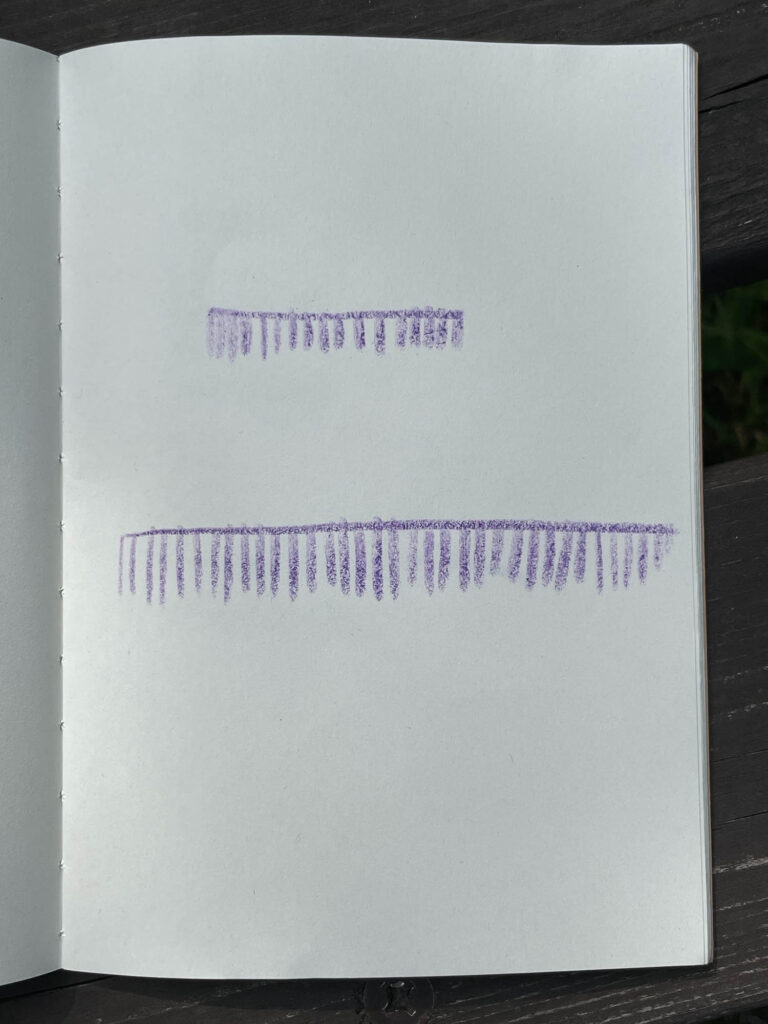
Untitled Agnes Ritli

Two – Agnes Ritli
***
Matsugawa
The milky waters
of the river of pines flow
over weirs and under
Kokeshi Bridge the milky
water flows south to the sea
- Martin Edmond
松川
堰越えの
流れ松川
乳白色
こけし橋下
南へ、海へ
- マーティン・エドモンド (訳・マユ)
***
Plum rain on Matsukawa
Make it flow
With no words
Cross over
The dolls
Of Kokeshi Bridge
A secret smile
- Mayu
松川の梅雨
流れ、
言葉なく
こけし橋
渡り人形
密かな微笑み
- マユ
***
17 heures
Retentissent sur le pont
Des nuages menaçants étendent leurs ombres
Le vent n’en finit plus d’ébouriffer mes cheveux
Ni l’eau de cette rivière de s’écouler sous mes pieds
Une pensée chasse l’autre
L’éclaircie m’enveloppe de sa lumière
Perpétuel est le Mouvement
- Antoine Malbaut
午後5時
橋の上
脅威の雲が影を落とす
風が髪をなびかせる
この川の水は足元を流れ
ひとつの思いが別の思いを追い
稲妻の光でに包まれる
永遠の動き
- アントン・マルボー (訳・マユ)
***
せみのこえ
緑豊かな
ステージ場
- 渡邊崇
Cry of cicadas
With abundant greenery
Place for stage space
- ― Watanabe Takashi (訳・マユ)
***
Hajime Kamainu (at Kattamine Shrine Satomiya)
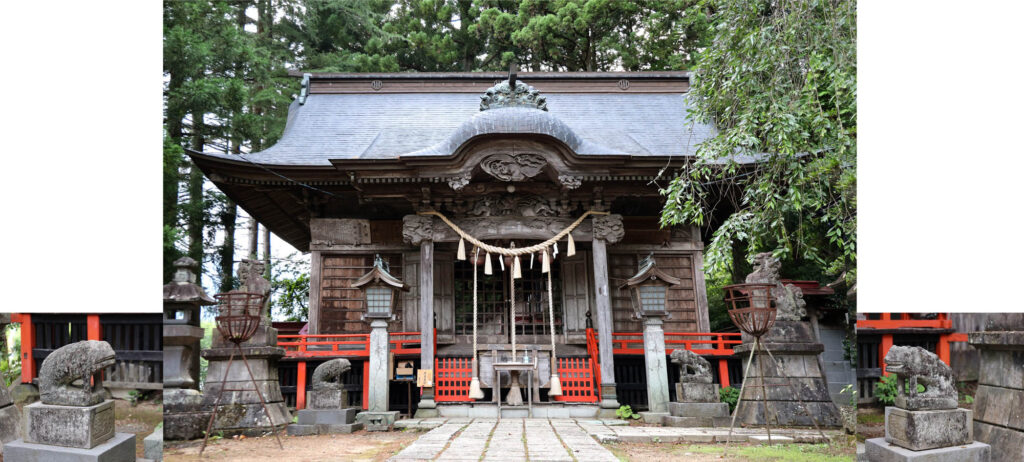
Kattamine Shrine (Satomiya). Photo by Mayu Kanamori
Komainu are pairs of statues of lion-like creatures guarding shrines and temples. Often the pair are similar or identical, except that one of them has its mouth closed, and the other, open.
The types protecting the town Kattamine Shrine are in the Hajime, Izumo Kamaegata and the Gokoku styes. The Hajime komainu were made during the Edo period when komainu were not common. They lack three-dimensionality and look like frogs. It is thought that the stonemason and the priest were both ignorant, and they were built according to hearsay.
In fact, during the nineteenth century an edict had come from Edo instructing all temples and shrines to make komainu and many people throughout the land, not just in Togatta, were unsure as to what they should look like. This has led to the construction of a great variety of types.
The komainu of the Izumo Kamaegata have their buttocks high up and look as if they are about to attack. They are three dimensional and precisely built using kimachi stone from Izumo (present day Shimane Prefecture). Many were built during the Edo to Taisho periods, and spread around the country by kitamaebune, the northern bound trading boats. The Gokoku style komainu have thick limbs with puffed out chests.
***
梅しごと
まだかと知り得
立つ雀
先を見ればや
社の狛犬
- 佐藤雅宣
Working the plums
Wanting to know when
Standing sparrows alight
Looking ahead I see
Towards the shrine Komainu
- Satoh Masanori (trans. Mayu)
***
Hajime Komainu
A green dragon fly
with black tipped wings alights
upon the haunches
of a dog like a frog with
rows of sharp teeth and a snarl
- Martin Edmond
黄金の羽先の
緑のとんぼ
尖った歯、唸り声上げる
カエルのような
犬の腰に
降りる
- マーティン・エドモンド
***
If We Are Hajme Koma Inu Sculptors
We are sculptors in Shrine Zao
If learn to conjecture a life because we got numb and confusing
Once upon a time the sculptor made a Shrine guard dog that turned out several centuries later to look more like a frog than a dog
We are sculptors in Shrine Zao
If touching things that are uncertain and then as if believing the suggestion
Once upon a time people read omens, recited prayers and communicated wisdom to the Beyond, preferring to ask rather than try
We are sculptors in Shrine Zao
If craving to joke but lacks humor, when life makes fun of us, we are no desire to laugh
Once upon a time the next generation visited and asked whether the face of an old era, dog really like a frog? Are puppies really as cute as tadpoles?
We can choose not to become sculptors in Shrine Zao.
If we make a peace with emptiness because knowledge will come to curious humans.
- Intan Anggita Pratiwie
もし私たちがハジメコマイヌの石工だったなら
私たちは蔵王の神社の石工
人生を推測することを学ぶなら、しびれ、混乱するからこそ
その昔、石工は神社の番犬を作ったが
数世紀、いうよりカエルに似ていることが判明
私たちは蔵王の神社の石工
その暗示を信じるかのように、不確かなものに触れては
知恵をあの世へ、祈りを唱え、人々はお告げを読みとり、その昔に伝えた
私たちは蔵王の神社の石工
冗談を言いたくてもユーモアがなければ
人生から馬鹿にされても笑う気にはならない
犬は本当に、古い時代の顔、次の世代が訪ねてきて、
昔々子犬は本当にオタマジャクシのよう?カエルのよう? かわいい?
蔵王の神社の石工にならないという選択もある
好奇心旺盛な人間たちに、もし私たちが虚無と和解すれば
知識がもたらされるかもしれない
-インタン・アンギッタ・プラティウィ (訳・マユ)

Hajime Komaiunu on left facing the shrine.
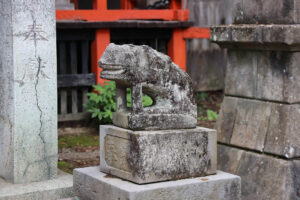
Hajime Komaiunu on right facing the shrine.
Ootorii (and the bridge over Nigori-kawa River)
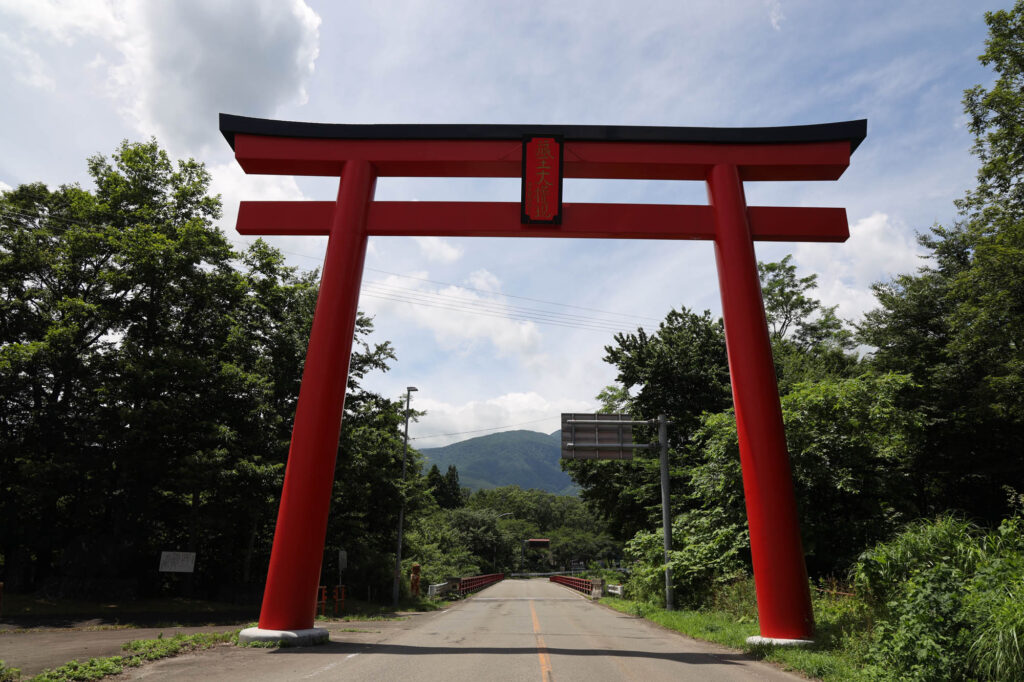
Otorii at the start of the Zao Echo Line. Photo by Mayu Kanamori
The Zao Daigongen Otorii is a large torii gate situated near the intersection of Routes 457 and 12, where the Zao Echo Line begins. Next to this torii gate is an unnamed bridge that runs over the Nigori-kawa River. The water from Nigori-kawa comes directly from the Okama crater, and the minerals make this river look opaque and also make it uninhabitable for fish.
On the parkland between the Otorii and the bridge is a kahi or song monument in memory of poet Kagawa Susumu (1910-1998), who visited and wrote about Zao. This is the only stone monument with a poem inscribed on it that the artists found during their two-week stay.
The artists recommend that this monument be included in tourist brochures and that other poetry monuments be built on this site.
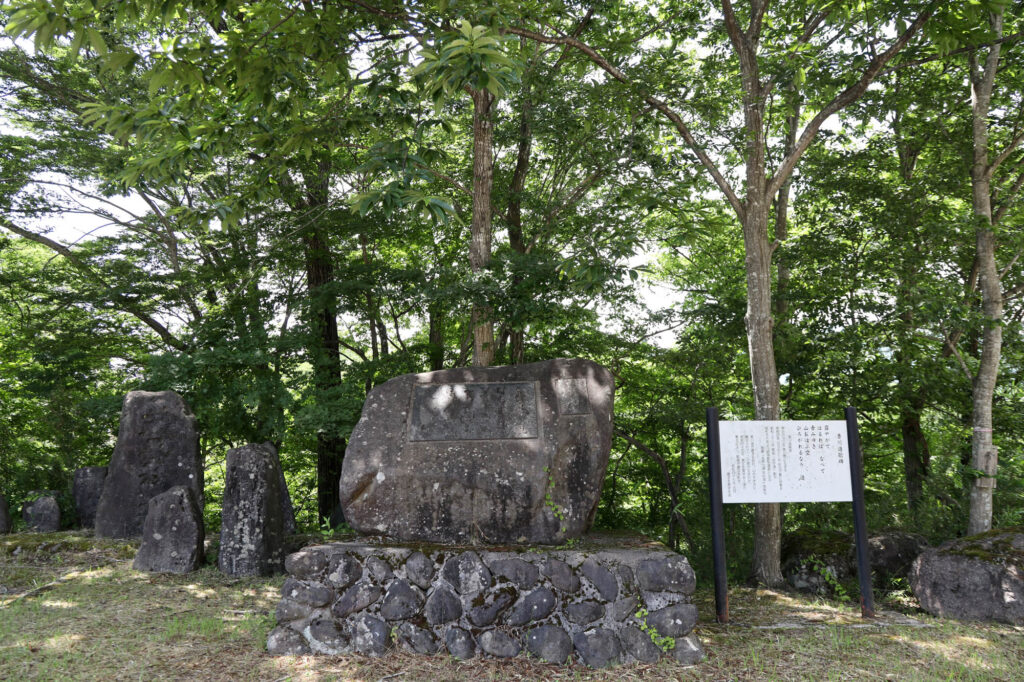
Stone monument with Kagawa Susumu’s poem about Zao.

Sign by the stone monument with Kagawa Susumu’s poem and biographical notes.
***
蝉の声
蔵王を仰ぎし
大鳥居
- 佐藤京子
Call of cicadas
Gazing up towards Zao
Otorii
- Satoh Kyoko (trans. Mayu)
***
文月の
沢音聞こえゆる
大鳥居
- 佐藤京子
In the July moon
Listening to river sounds
Otorii
- Satoh Kyoko (trans. Mayu)
***
濁川
蔵王にそびえる
佇まい
心惹かれて
我勇み足
- 永井京花
Nigori-kawa
Towering over Zao
Just by standing there
My heart is moved and pulled
I’m carried away and lost
- Nagai Kyoka (trans. Mayu)
***
Nigorigawa
By the cloud river
half hidden among the weeds
both sides of the road
we are metal kokeshi
rusting silently away
- Martin Edmond
濁川
雲川のほとりに
雑草に半隠れ
道の両わきに
我らは金属こけし
静かに錆びる
- マーティン・エドモンド (訳・マユ)

By the bridge over Nigori-kawa . Photo by Martin Edmond
Zao

Zao Mountain Range. Photo by Mayu Kanamori
Zao is short for the Zao Mountain Range, which is part of the larger Ou Mountain Range. The mountains seen from the Miyagi Prefecture side of the ranges are, left to right (south to north): Fubou-san (1705 meters), Minami, Byobu-dake (1810 meters), Byobu-dake (1825 meters), Ushiroeboshi-dake (1686 meters), Katta-dake (1758 meters), Kumano-dake (1841 meters) and Myogobo (1491 meters). On the other side of the ranges lies Yamagata Prefecture.
When esoteric Buddhism was combined with ancient mountain worship and Shugendo (mountain asceticism) was born, and ascetic practices were undertaken deep in the mountains, Zao was a place for such things to happen. The name Zao comes from Zao Gongen, a Buddhist statue that was enshrined on the mountain.
There are published poems about Zao. In the 2-week residency period, the artists have found in the Zao-machi Public Library:
- Zao no Uta (Tanka Shinbunsha 1988) by Sakuma Akira
- Zao no Yama by Otsuki Hirashichi in his collection Sarasoju (Tohoku Araragi Koriyama 1978)
- Two untitled tanka poems mentioning Zao by Matsuyuki Akira in Zao Tankasha Second Collection (Zao Tankasha, 2019)
***
夏陽差す
見上げる先に
蔵王山
- 和心
The summer rays fall
Seeing above and ahead
Zao Mountains
- Washin (trans. Mayu)
***
Strange Summer
Humans have the option to walk far.
I chose to stop at a place that is 4,800 km from my house. Without looking at the map, without knowing exactly where this is.
Here the mountains Zao Ranger looks at me boldly, say; “stay here, as long as you want.”
It turns out that this place is also home to me.
Bringing of childhood memories, rice field, hills and mountains surround the valley.
We also don’t have time to complain because the hot or rain it feels good.
The sun came up earlier than usual I know. He told me to enjoy the morning longer. Time is running slow. Longing was scattered among the Ajisai flowers which were still wet after last night’s rain.
The sun came up earlier than usual I know. But people in Zao take a late shower because the onsen only opens at 10.
Togatta is full of sounds of nature, occasionally I meet humans. Maybe no more than five people a day. The others have left, maybe they can’t stand it, it’s too quiet here.
I tried to make poems while looking at the green scenery. But this village moves slowly, words come but it’s hard for me to write quickly, as slowly as I wait for the Michelin Soba shop which is open only on weekends.
I gazed up at the Zao Mountains before going to bed, laying down in a bath where it was dark enough that I could see the stars in an unpolluted sky.
Humans have the option to walk far.
I chose to stop at a place that is 4,800 km from my house. Without knowing what is here and who will meet me. Everything is outlandish. But warm.
It turns out that I and myself inside, love alienation.
Because here the wind bring drizzle, say; “stay here, as long as you want.” She imitate the mountains to me. It’s as if she knows I miss my family, but is maze because here is the end; peace.
Humans have the option to walk far.
Do you choose to stop at a place far from your home?
- Intan Anggita Pratiwie
不思議な夏
人間には遠くまで歩くという選択肢がある。
私は自宅から4800キロ離れた場所に立ち寄ることにした。地図も見ず、ここがどこかもよく知らずに。
ここで蔵王連山が大胆にも私を見て言った。「ここにいろ、好きなだけいろ 」と。
ここは私にとって故郷でもある。
幼い頃の思い出の田んぼ、丘、山が谷を取り囲んでいる。
暑かろうが雨が降ろうが、気持ちいいから文句を言う暇もない。
太陽はいつもより早く昇った。朝をもっと長く楽しめって。時間はゆっくり流れている。昨夜の雨でまだ濡れているあじさいの花の中に、憧れの花が散っていた。
日が昇るのがいつもより早かったのは知っている。でも蔵王の人たちは遅い時間にシャワーを浴びる。
遠刈田温泉は自然の音に満ちている。1日に5人くらいかな。他の人たちは帰ってしまった。ここは静かすぎるから、耐えられないのかもしれない。
私は緑の景色を見ながら詩を作ろうとした。しかし、この村の動きはゆっくりだ。言葉は出てくるが、素早く書くのは難しい。週末しか営業していないミシュラン蕎麦屋を待つのと同じくらいゆっくりだ。
寝る前に蔵王の山々を見上げ、汚染されていない空の星が見えるほど暗い風呂に横になった。
人間には遠くまで歩くという選択肢がある。
私は自宅から4800キロ離れた場所に立ち寄ることにした。ここに何があるのか、誰が出迎えてくれるのかも知らずに。すべてが突飛だ。でも温かい。
私は、そして私自身も、疎外感を愛していることがわかった。
なぜなら、ここでは風が霧雨を運んでくるからだ。彼女は私に山の真似をする。まるで、私が家族を恋しがっていることを知っているかのように。
人間には遠くまで歩く選択肢がある。
あなたは家から遠く離れた場所で立ち止まることを選びますか?
- インタン・アンギッタ・プラティウィ (訳・マユ)
***
Kuma
Hot spring water flows
with a strong mineral smell
down Zao Mountain
and right past our open door
through which no bear has yet come
- Martin Edmond
熊
温泉は流れる
強烈なミネラル臭と共に
蔵王山を下り
開けっ放しの玄関前を流れるが
熊はまだ来ない
- マーティン・エドモンド (訳・マユ)
Aoso-san (Aoso-yama)
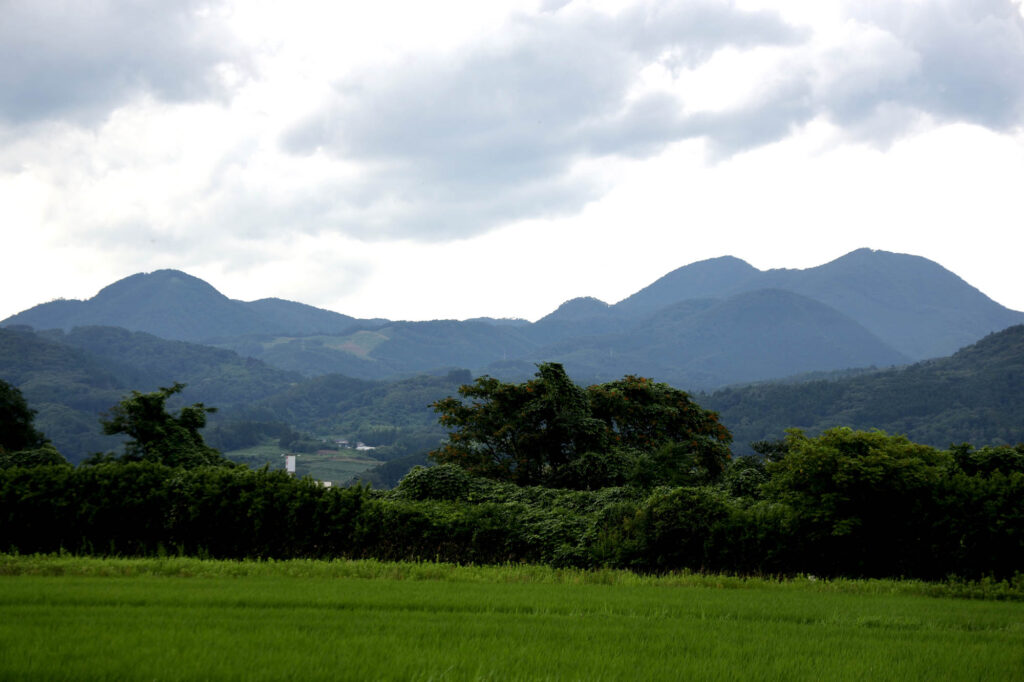
Aoso-san. Photo by Mayu Kanamori
Aoso-san (799 meters) is an independent old bipyramid volcano on the eastern side of the Zao Mountain Range, southeast of the central Togatta Onsen district. It has several peaks, including the Akera peak to the west is 10 m higher than elsewhere on Aoso-san.
It is said that in the Nara and Heian periods, the mountain was called Okatta, and was worshipped to calm the eruption of Zao’s Katta-dake Ridge. Aoso Shrine was built on the summit of the mountain in the late Edo period (1603-1868), and religious mountaineering by ascetic practitioners was popular by the end of the Edo period.
Kattamine Shrine, which is now in Togatta Onsen and on the top of Katta-dake was said to be once on Aoso-san. Yakushi-do Temple still stands about third of the way up the mountain, protected by local villagers.
Many Jomon period remains are found on the foothills of this mountain, especially on the eastern foothills. Kitaharao pioneer’s resettlement district is on the western foothills of Aoso-san.
There are published poems about Aoso-san. The artists found during the 2-week residency at the Zao-machi Public Library:
- Aoso no Yama by Endo Tadashi from his collection Shima Aoki Chizu (Hiiragi Shobo, 2016)
- Aoso-san by Yasobe Tokio from his collection Yukuefumei no Kajintachi (Shigaku-sha, 1991)
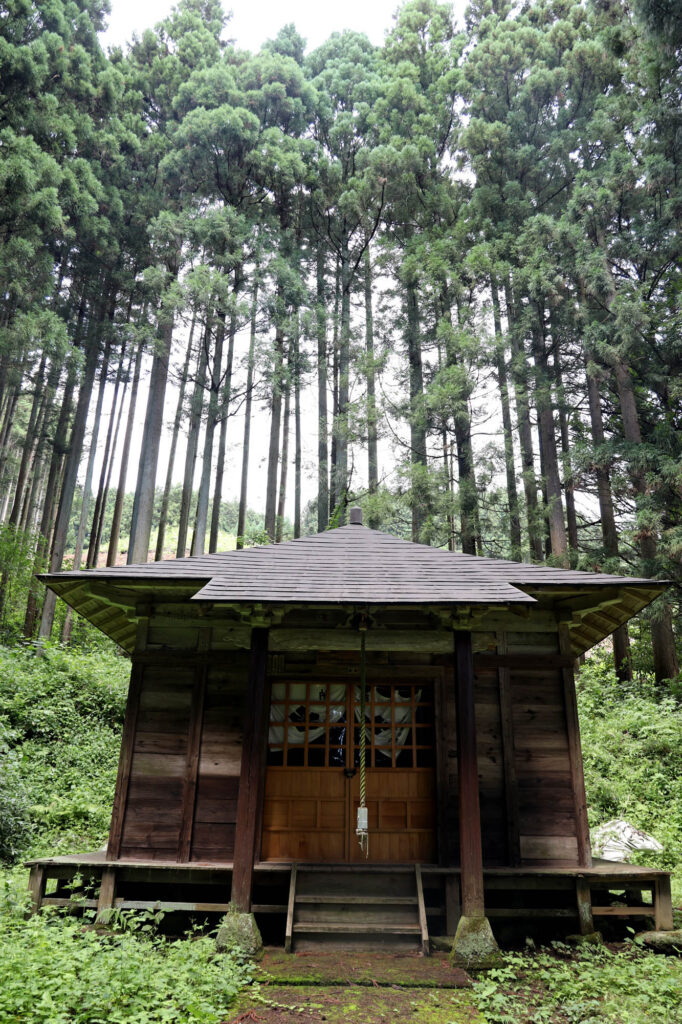
Yakushido Temple at Aoso-san. Photo by Mayu Kanamori
At Yakushido
A cicada caught
in a yellow spider web
shall I set it free?
- Martin Edmond
薬師堂にて
黄色のクモの巣に
蝉がひっかかっている
自由にさせようか
- マーティン・エドモンド (訳・マユ)
***
青麻山
飄々と
暗闇に潜む
獣たち
今宵も始まる
愉快な祭祀
-永井京花
Aoso-san
Aloof, transcending
And lurking in the darkness
The beasts, once again
Tonight, another joyful
Ritual festivities
-Nagai Kyoka (trans. Mayu)
***
Dream of Aoso-san
On the night I arrived, I dreamed of Aoso-san
towering under the indigo sky.
From the direction of Sirius,
a falling star descended to its summit,
hovered, and landed without a sound.
Cedar trees began to sway,
beeches rustled and magnolias clapped
uneven beats to a strange tune,
high in pitch of a slender flute,
low in sound of secret singing:
I am
since the beginning of beginnings.
Longer than anyone remembers,
when my name was Okatta-dake
and even before, when my name was
never uttered.
I endure the burden of pylons
to light, warm and cool,
and cutting of trees, and planting of trees
for shrines and temples
built, worshiped, and moved.
Since the beginning of beginnings.
I am.
In the morning I wrote a poem
and asked the fallen star to take me to the temple.
Deep in the woods of Aoso-san
protected by families since antiquity,
a thin man with big ears guided me
up moss-covered step stones
to Yakushi-do, medicine teachers’ temple.
The slash line was at her edge.
Hands together, I speak my dream.
- Mayu
青麻山の夢
到着した晩、藍色の空の下に
そびえ立つ青麻山の夢を見た。
シリウスの方角から
流れ星が山頂に降りて、
漂い、音もなく着地した。
杉の木が揺れ始め、
ブナはざわめき、モクレンは拍子を
不規則に打ち鳴らし、奇妙な曲を奏でる
細い笛のような甲高い音色
秘密のささやきのような低い歌声:
おらほの
昔の昔から
誰も覚えとらん昔っから、
おがった山と呼ばれたころから
その前もおらが名前を
誰も云わねかったころから、
灯り、あっため、涼んで
鉄塔の重荷に耐えて
木、切ったり、木、植えたり、
神社や寺の柱に
なったり、祀られたり、移ったり
昔の昔から
おらはここにいる。
朝、青麻山の詩を詠んだ。
降る星に寺に連れたいと頼んだ。
青い森の奥深く
古くから守ってきた家の
耳の大きな痩せた男が
案内をしてくれた。
苔に覆われた踏み石を登り
薬師堂へと。
そこは切り裂き線の縁ぎわだった。
手を合わせ、夢を伝えると誓った。
- マユ
***
Haiku
for Mayu
Utamakura:
the pillow of snow on top
of Aoso-san
- Martin Edmond
マユのための句
歌枕:
雪の敷妙
青麻山
- マーティン・エドモンド (訳・マユ)
Kitaharao
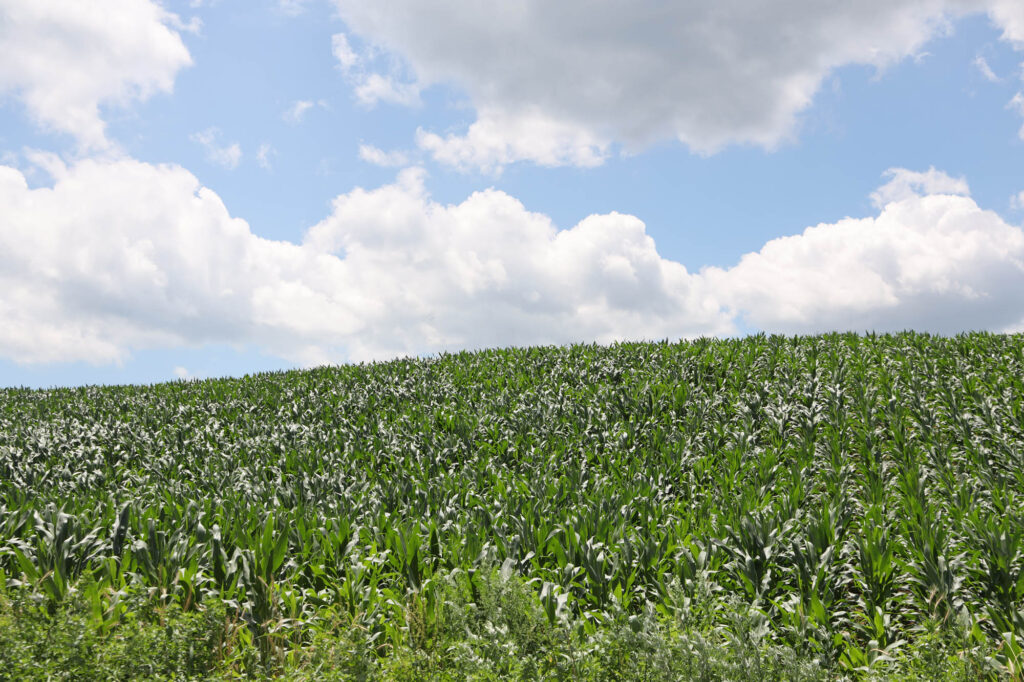
Corn fields at Kitaharao. Photo by Mayu Kanamori
Kitaharao is a dairy farming village, pioneered by people who once lived in what is now the Republic of Palau in the South Pacific; they were resettled here after World War II. Palau had become a Japanese colony in 1920, as part of the South Seas Mandate, which was a League of Nations initiative following World War I granting German colonies in the South Pacific to the Empire of Japan. Kita means north, and harao was chosen by the settlers because its phonetic similarity with Palau.
On its western foothills, where the road to Aoso-san meets Route 457, there are three monuments. One for the spirit of Kitaharao pioneers, another for the spirit of cows, and one commemorating the visit of the then Japanese Emperor Akihito and Empress Michiko in 2015. The Emperor and Empress visited this area to pay their respects to the pioneers.
The poet Izumi Yukihisa (1936-1972), who was from Palau, settled in Kitaharao after the war, working as a farmer as well as helping a kokeshi maker and driving a taxi in town.
The artists recommend a poetry stone monument with one of Izumi’s poems on it be built next to the other monuments.

Three monuments at Kitaharao. Photo by Mayu Kanamori
***
血のにじむ
苦労で開きし
北原尾
- 佐藤京子
Bleeding through and out
Pioneered with hardships
Kitaharao
- Satoh Kyoko
***
Song of Kitaharao
On the slopes of Aoso-san
in a green place where once
an Emperor and his consort came
we remember the Pacific
Island which was our home
We remember the streets of Koror
& the palms of Babeldaob
the katsuo leaping
out beyond the reef
the sound of surf on the sand
Here on Aosa-san
we made another home
in a green valley where steam
rises out of the ground
& ancient people lived
Among bears and wild boars
& vipers women milk
& cows graze in the fields
we have made another home
on the slopes of Aoso-san
- Martin Edmond
北原尾の歌
青麻山の緑の斜面に
かつて天皇と妃が
訪れ、太平洋を忘れない
故郷だった島
コロールの街の想い出と
バベルダオブのヤシの木と
鰹が飛ぶ
リーフの向こうに
砂浜の波の音を聴く
ここ青麻山で
もうひとつの故郷
湯気が立ち上る緑の谷に
古代の人々が暮らした
熊と猪と毒蛇との
乳を酌む女集
牛は野原で草を食む
もうひとつの故郷を
青草山の斜面に創った
- マーティン・エドモンド (訳・マユ)
Togatta Onsen Yu-no-Machi Bus Stop

Bus shelter gallery machiaijo. Photo by Mayu Kanamori
Togatta Onsen Bus Stop services three bus routes. The Togatta Line operated by Miyako Bus Company, which runs between Miyagi Zao Royal Hotel in Togatta and the Shiroishi Zao Shinkansen train station in Shiroishi, stopping at 38 stops in between; the Okawahara Line, also operated by Miyako Bus Company, runs between Miyagi Royal Hotel and Okawahara Station and stops at 41 stops in between; and the Sendai-Zao Line operated by Miyagi Kotsu Company, which runs between Miyagi Royal Hotel and Sendai, and stops at 9 stops in between. There is a poem by Sendai born poet Miura Mai on the wall of machiaijo, a gallery by the Togatta Onsen Yu-no- Machi Bus Stop on the northern side of the street. This is where buses leave Togatta to go to out to the wider world. Machiaijo means waiting room, and this gallery looks like a bus shelter.
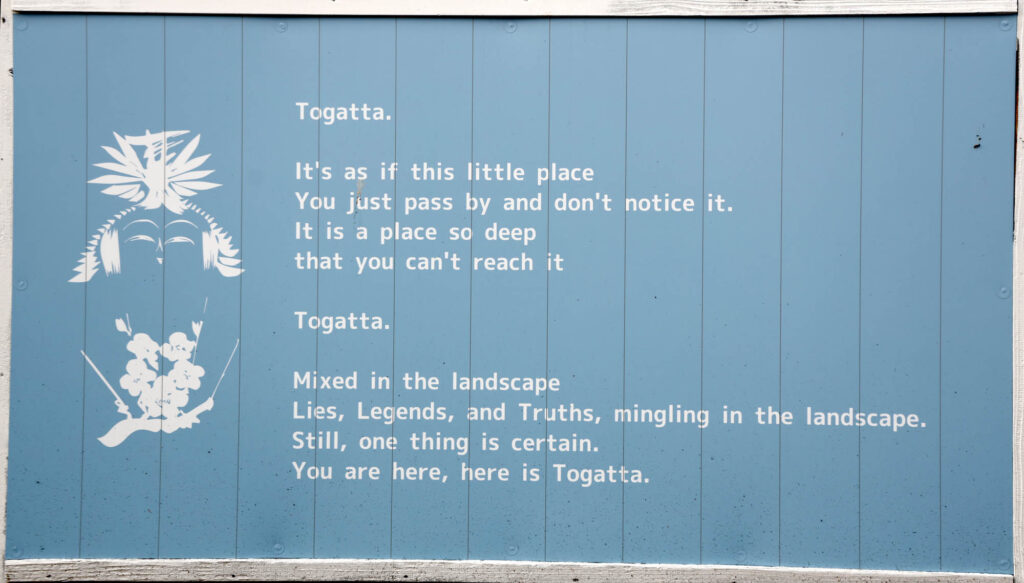
Poem at the bus stop gallery machiaijo by Miura Mai. Photo by Mayu Kanamori*
幾千の
歴史見届けし (ドラマ見届けし)
Bus Room(バスルーム)
- 佐藤京子
Thousands of dramas
History now overseen
Bus Room
- Satoh Kyoko (trans Mayu)
***
The Togatta Bus Stop
You can take a bus
to the mountains or the sea
or you can go west
to Aoso-san and meet
Dogu on Matsukawa
They will tell you this:
sit always with a straight back
yet bend with the wind
the mountains will watch over you
the river flows to the sea
- Martin Edmond
遠刈田のバス停
バスに乗って
山や海へ行くことも
西の青曽山まで行って
松川で土偶と
出会うこともある
彼らは教えてくれる:
背筋を伸ばして座れ
風に吹かれて曲がれ
山が見守ってくれる
川は海へと流れる
- マーティン・エドモンド (訳・マユ)
